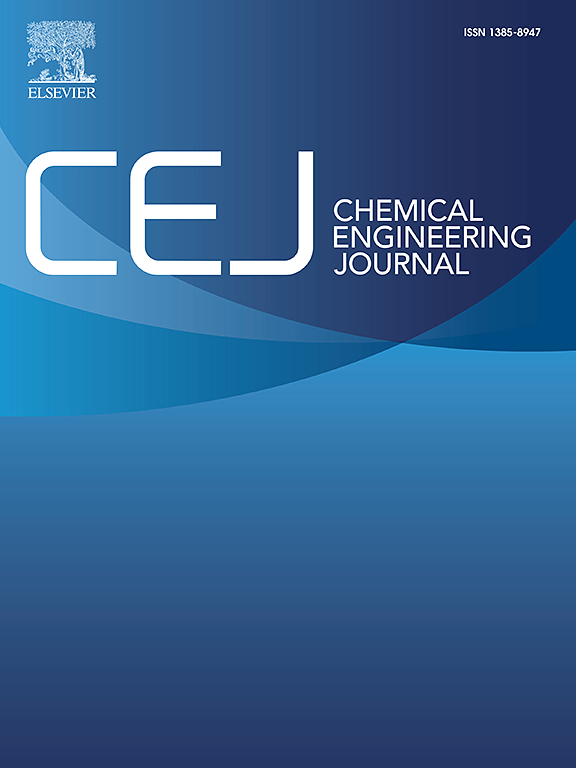具有表面等离子体共振的生物矿化柔性金属纳米膜粘附异质材料
IF 13.2
1区 工程技术
Q1 ENGINEERING, CHEMICAL
引用次数: 0
摘要
具有金属沉积层的柔性衬底广泛应用于可穿戴设备的制造。然而,由于沉积条件和衬底性能之间多方面的相互作用,金属沉积过程往往是复杂和令人不满意的。因此,寻找一种方便有效的方法来改善柔性基板与金属界面之间的结合是至关重要的。本研究提出了一种相变蛋白诱导的金矿化策略,通过促进金沉积在与相变蛋白粘附的柔性底物上,从而增强金属与基质的相互作用。由二硫键断裂驱动的相变蛋白(包括乳白蛋白、溶菌酶和牛血清白蛋白)的自组装和构象适应,提供了丰富的结合位点并稳定了结构,使金离子在柔性底物上可靠地矿化。所得的金修饰柔性衬底保持了原始材料固有的柔韧性,同时表现出优异的表面增强拉曼散射(SERS)性能、再现性和机械耐久性,表现出与各种衬底的相容性,可用于尿中甲氨蝶呤的检测,范围从10−8到10−3 M。本研究为优化金属在柔性材料上的粘附性提供了一种仿生方法,有助于开发具有生物相容性和稳定性的金属包覆柔性材料。本文章由计算机程序翻译,如有差异,请以英文原文为准。
Biomineralized flexible metal nanofilms with surface plasmon resonance for adhesion of heterogeneous materials
Flexible substrates with metal deposition layers are widely used in the fabrication of wearable devices. However, metal deposition processes are often complex and unsatisfactory due to the multifaceted interplay between deposition conditions and substrate properties. Therefore, it is crucial to find a convenient and effective method to improve the bonding between flexible substrates and metal interfaces. In this study, a phase transition protein-induced gold mineralization strategy is proposed to enhance the metal-substate interactions by facilitating gold deposition onto flexible substrates adhered with phase transition proteins. The self-assembly and conformational adaptation of phase transition proteins (including lactalbumin, lysozyme, and bovine serum albumin) driven by disulfide bond cleavage, provide abundant binding sites and stabilize the structure, enabling the reliable mineralization of gold ions on flexible substrates. The resulting gold-modified flexible substrates maintain the inherent flexibility of the original materials while manifesting excellent surface-enhanced Raman scattering (SERS) properties, reproducibility, and mechanical durability, exhibiting compatibility with various substrates, which can be applied for the detection of methotrexate in urine with a wide range from 10−8 to 10−3 M. This research provides a biomimetic approach to optimize metal adhesion on flexible materials and contributes to the development of biocompatible and stable metal-coated flexible materials.
求助全文
通过发布文献求助,成功后即可免费获取论文全文。
去求助
来源期刊

Chemical Engineering Journal
工程技术-工程:化工
CiteScore
21.70
自引率
9.30%
发文量
6781
审稿时长
2.4 months
期刊介绍:
The Chemical Engineering Journal is an international research journal that invites contributions of original and novel fundamental research. It aims to provide an international platform for presenting original fundamental research, interpretative reviews, and discussions on new developments in chemical engineering. The journal welcomes papers that describe novel theory and its practical application, as well as those that demonstrate the transfer of techniques from other disciplines. It also welcomes reports on carefully conducted experimental work that is soundly interpreted. The main focus of the journal is on original and rigorous research results that have broad significance. The Catalysis section within the Chemical Engineering Journal focuses specifically on Experimental and Theoretical studies in the fields of heterogeneous catalysis, molecular catalysis, and biocatalysis. These studies have industrial impact on various sectors such as chemicals, energy, materials, foods, healthcare, and environmental protection.
 求助内容:
求助内容: 应助结果提醒方式:
应助结果提醒方式:


